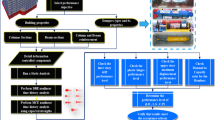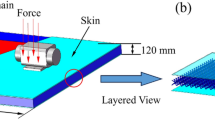Abstract
This study develops two new indices in structural optimization to minimize peak response and settling time of free vibration, respectively. The two new indices are developed by substituting weight functions into a classic quadratic integral index. With the weight functions, the contributions of structural responses in different time intervals to the value of performance index can be adjusted according to requirements. In such a way, the new indices can approximately evaluate structural performances in reduction of the peak response and settling time, respectively. The new indices have the advantages that they retain the benefits of the classical index for the ease of numerical calculation and sensitivity analysis. Furthermore, they are easy to implement by slightly modifying various developed optimization approaches. Finally, four numerical examples are considered. The proposed two new indices show good performance in reducing the peak response and settling time of free vibration.

































Similar content being viewed by others
References
Alfouneh M, Tong L (2017) Maximizing modal damping in layered structures via multi-objective topology optimization. Eng Struct 132:637–647
Alfouneh M, Tong L (2018) Topology optimization of nonlinear structures with damping under arbitrary dynamic loading. Struct Multidiscip Optim 57:759–774
An SQ, Zou HL, Deng ZC, Hu WP (2019) Dynamic analysis on hub–beam system with transient stiffness variation. Int J Mech Sci 151:692–702
Bouafia K, Kaci A, Houari MSA, Benzair A, Tounsi A (2017) A nonlocal quasi-3D theory for bending and free flexural vibration behaviors of functionally graded nanobeams. Smart Struct Syst 19:115–126
Cole MOT, Shinonawanik P, Wongratanaphisan T (2018) Time-domain prefilter design for enhanced tracking and vibration suppression in machine motion control. Mech Syst Signal Pr 104:106–119
Ding Z, Li L, Zou G, Kong GY (2019) Design sensitivity analysis for transient response of non-viscously damped systems based on direct differentiate method. Mech Syst Signal PR 121:322–342
Dong X, Yoon D, Okwudire CE (2017) A novel approach for mitigating the effects of pre-rolling/pre-sliding friction on the settling time of rolling bearing nanopositioning stages using high frequency vibration. Precis Eng 47:375–388
Du J, Olhoff N (2007) Topological design of freely vibrating continuum structures for maximum values of simple and multiple eigenfrequencies and frequency gaps. Struct Multidiscip Optim 34:91–110
Giaralis A, Taflanidis AA (2018) Optimal tuned mass-damper-inerter (TMDI) design for seismically excited MDOF structures with model uncertainties based on reliability criteria. Struct Control Hlth 25:1–22
Gomez F, Spencer BF (2019) Topology optimization framework for structures subjected to stationary stochastic dynamic loads. Struct Multidiscip Optim 59:813–833
Guo X, Cheng GD (2010) Recent development in structural design and optimization. Acta Mech Sinica 26:807–823
He ZC, Wu Y, Li E (2018) Topology optimization of structure for dynamic properties considering hybrid uncertain parameters. Struct Multidiscip Optim 57:625–638
Jang HH, Lee HA, Lee JY, Park GJ (2012) Dynamic response topology optimization in the time domain using equivalent static loads. AIAA J 50:226–234
Kalman RE, Bertram JE (1960) Control system analysis and design via the “second method” of Lyapunov: I—continuous-time systems. J Basic Eng 82:371–393
Kang BS, Choi WS, Park GJ (2001) Structural optimization under equivalent static loads transformed from dynamic loads based on displacement. Comput Struct 79:145–154
Kang BS, Park GJ, Arora JS (2006) A review of optimization of structures subjected to transient loads. Struct Multidiscip Optim 31:81–95
Kang Z, Zhang X, Jiang S, Cheng GD (2012) On topology optimization of damping layer in shell structures under harmonic excitations. Struct Multidiscip Optim 46:51–67
Kiang CT, Spowage A, Yoong CK (2015) Review of control and sensor system of flexible manipulator. J Intell Robot Syst 77:187–213
Li X, Ho DWC, Cao J (2019a) Finite-time stability and settling-time estimation of nonlinear impulsive systems. Automatica 99:361–368
Li QQ, He ZC, Li E, Cheng AG (2019b) Design of a multi-resonator metamaterial for mitigating impact force. J APPL PHYS 125: 035104-1-14.
Li QQ, He ZC, Li E, Cheng AG (2019c) Design and optimization of three-resonator locally resonant metamaterial for impact force mitigation. Smart Mater Struct 27: 095015-1-32.
Liu H, Zhang WH, Gao T (2015) A comparative study of dynamic analysis methods for structural topology optimization under harmonic force excitations. Struct Multidiscip Optim 51:1321–1333
Marano GC, Greco R, Chiaia B (2010) A comparison between different optimization criteria for tuned mass dampers design. J Sound Vib 329:4880–4890
Nguyen R, Murmann B (2010) The design of fast-settling three-stage amplifiers using the open-loop damping factor as a design parameter. IEEE T Circuits-I 57:1244–1254
Niu B, He X, Shan Y, Yang R (2018) On objective functions of minimizing the vibration response of continuum structures subjected to external harmonic excitation. Struct Multidiscip Optim 57:2291–2307
Rong JH, Xie YM, Yang XY, Liang QQ (2000) Topology optimization of structures under dynamic response constraints. J Sound Vib 234:177–189
Saaed TE, Nikolakopoulos G, Jonasson JE, Hedlund H (2015) A state-of-the-art review of structural control systems. J Vib Control 21:919–937
Singhose W (2009) Command shaping for flexible systems: a review of the first 50 years. Int J Precis Eng Man 10:153–168
Smoczek J, Szpytko J (2017) Particle swarm optimization-based multivariable generalized predictive control for an overhead crane. IEEE-ASME T Mech 22:258–268
Sun L, Yin W, Wang M, Liu JT (2018) Position control for flexible joint robot based on online gravity compensation with vibration suppression. IEEE T Ind Electron 65:4840–4848
Svanberg K (1987) The method of moving asymptotes—a new method for structural optimization. Int J Number Meth Eng 24:359–373
Takezawa A, Makihara K, Kogiso N, Kitamuraa M (2014) Layout optimization methodology of piezoelectric transducers in energy-recycling semi-active vibration control systems. J Sound Vib 333:327–344
Takezawa A, Daifuku M, Nakano Y, Nakagawa K, Yamamoto T, Kitamura M (2016) Topology optimization of damping material for reducing resonance response based on complex dynamic compliance. J Sound Vib 365:230–243
Takezawa A, Yamamoto T, Zhang XP, Yamakawa K, Nakano S, Kitamura M (2019) An objective function for the topology optimization of sound-absorbing materials. J Sound Vib 443:804–819
Tan KT, Huang HH, Sun CT (2014) Blast-wave impact mitigation using negative effective mass density concept of elastic metamaterials. Int J Impact Eng 64:20–29
Wang BP, Kitis L, Pilkey WD (1984) Transient response optimization of vibrating structures by Liapunov’s second method. J Sound Vib 96:505–512
Yan K, Cheng GD (2018) An adjoint method of sensitivity analysis for residual vibrations of structures subject to impacts. J Sound Vib 418:15–35
Yan K, Cheng GD, Wang BP (2016a) Adjoint methods of sensitivity analysis for Lyapunov equation. Struct Multidiscip Optim 53:225–237
Yan K, Cheng GD, Wang BP (2016b) Topology optimization of plate structures subject to initial excitations for minimum dynamic performance index. Struct Multidiscip Optim 53:623–633
Yan K, Cheng GD, Wang BP (2018a) Topology optimization of damping layers in shell structures subject to impact loads for minimum residual vibration. J Sound Vib 431:226–247
Yan K, Wang BP, Cheng GD (2018b) Residual vibration reduction for translation unconstrained or partially unconstrained structures by structural optimization. Comput Struct 210:12–27
Yun KS, Youn SK (2018) Topology optimization of viscoelastic damping layers for attenuating transient response of shell structures. Finite Elem Anal Des 141:154–165
Zhang L, Gao J, Chen X, Tang H, Chen Y, He YB, Yang ZJ (2017) A rapid vibration reduction method for macro–micro composite precision positioning stage. IEEE T Ind Electron 64:401–411
Zhao J, Wang C (2017) Topology optimization for minimizing the maximum dynamic response in the time domain using aggregation functional method. Comput Struct 190:41–60
Zhao J, Yoon H, Youn BD (2019) An efficient concurrent topology optimization approach for frequency response problems. Comput Method Appl M 347:700–734
Zhou P, Du J, Lü Z (2017) Topology optimization of freely vibrating continuum structures based on nonsmooth optimization. Struct Multidiscip Optim 56:603–618
Zhu M, Yang Y, Guest JK, Shields MD (2017) Topology optimization for linear stationary stochastic dynamics: applications to frame structures. Struct Saf 67:116–131
Zuo L, Nayfeh SA (2005) Optimization of the individual stiffness and damping parameters in multiple-tuned-mass-damper systems. J Vib Acoust 127:77–83
Data and code availability
The results of the optimized designs and the basic code of this work are available from the corresponding author on reasonable request.
Funding
This work is supported by the National Natural Science Foundation of China (Grant numbers: 11702052) and China Postdoctoral Science Foundation (Grant numbers: 2018 M640251, 2019 T120201).
Author information
Authors and Affiliations
Corresponding author
Ethics declarations
Conflict of interest
The authors declare that they have no conflict of interest.
Additional information
Responsible Editor: Ji-Hong Zhu
Publisher’s note
Springer Nature remains neutral with regard to jurisdictional claims in published maps and institutional affiliations.
Rights and permissions
About this article
Cite this article
Yan, K., Wang, B.P. Two new indices for structural optimization of free vibration suppression. Struct Multidisc Optim 61, 2057–2075 (2020). https://doi.org/10.1007/s00158-019-02451-z
Received:
Revised:
Accepted:
Published:
Issue Date:
DOI: https://doi.org/10.1007/s00158-019-02451-z




